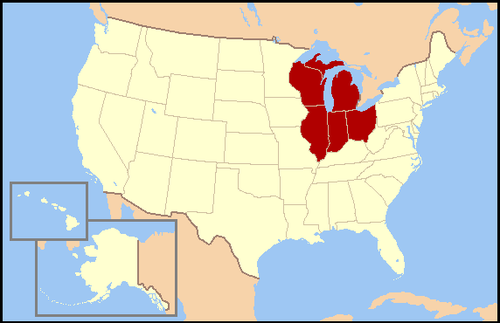East North Central | |
|---|---|
 | |
| Composition | |
| Metropolitan areas | |
| Area | |
• Total | 299,170 sq mi (774,800 km2) |
| Population (2020) | |
• Total | 47,368,533 |
| • Density | 158/sq mi (61/km2) |

TheEast North Central states is aregion of theUnited States defined by theU.S. Census Bureau, containing five states:Illinois,Indiana,Michigan,Ohio andWisconsin.[1] These states border theGreat Lakes,West North Central, theSoutheastern, andNortheastern states; the Eastern North Central states also share a land border withCanada through Michigan'sUpper Peninsula,southeastern, andmid-Michigan regions. As one of two subregional divisions used to categorize theMidwestern United States, East North Central closely matches the area of theNorthwest Territory, excluding a portion ofMinnesota.
The East North Central states also form a large part of theGreat Lakes region,[2] although the latter also includes Minnesota,New York,Pennsylvania and theCanadian province ofOntario. It has a low rate of population growth and the estimated population as of 2019 was 46,902,431,[3] though the 2020 census numbered 47,368,533 residents. The Great Lakes bordering the area provide access to theAtlantic Ocean via theGreat Lakes Waterway andSt. Lawrence Seaway, or by theErie Canal and theHudson River, or via theGulf of Mexico from theMississippi River and theIllinois Waterway.Chicago andDetroit—two of East North Central's largest cities—are among the majorports of the United States.
Culturally, this region of the U.S. has been historically influenced by the British and French;Anglo-American culture permeated states covering the region following theexpansion of the United States. Religiously, the East North Central states have been and remain predominantly affiliated withChristianity. Altogether, the five states are majorityCatholic,non- and inter-denominational,Methodist,Lutheran, andBaptist. The largest non-Christian religion has beenIslam.[4]

DuringEuropean colonization of the Americas, the modern-day East North Central states was occupied by numerous American Indian tribes; with the introduction ofEuropean Americans into the region, it was divided between theBritish colonial empire in America andNew France. The western portion of this region formed part ofFrench Louisiana,[5][6] and followingU.S. independence, the eastern half was ceded to the United States fromGreat Britain.[7] Since American settlement, the modern-day East North Central states has remained the most populous division of theMidwest despite the overall region's low population growth rates.
Geographically located within theNorth, East North Central is considered part of theMidwest andGreat Lakes regions, sharing maritime and land borders withCanada.[2] As half of the Midwest, the majority of it shares ahumid continental climate, and many of its coastal settlements encounterlake effect snow during the winter.
| State | 2019 estimate | Land area |
|---|---|---|
| Illinois | 12,671,821 | 57,915 |
| Indiana | 6,732,219 | 36,418 |
| Michigan | 9,986,857 | 96,716 |
| Ohio | 11,689,100 | 44,825 |
| Wisconsin | 5,822,434 | 65,497 |
In 2010, the East North Central states had a population of 46,421,564; this grew to an estimated 46,902,431 by 2019.[8] By the2020 United States census, the region's population increased to 47,368,533. Of its population,Illinois is the region's most populous with a 2020 population of 12,812,508.[9] Its least populous is Wisconsin, with 5,893,718 residents.[10]Chicago is the region's most populous city and largest metropolitan area. According to the 2010American Community Survey, 49.1% of the residents were male and 50.9% were female. Approximately 24.0% of the population were under 18 years of age, and 13.4% were over 65 years of age, and the median age for the region was 39.2.
In terms of race and ethnicity as of 2012,White Americans made up 79.5% of the population, of which 75.7% were whites of non-Hispanic origin.Black Americans composed 12.1% of the region's population, of which 11.9% were blacks of non-Hispanic origin.American Indians and Alaskan Natives were 0.4% of the population andAsians were 2.7%. People who were of two or more races formed 2.1% of the population; andHispanics and Latinos of any race made up 7.6%.[11]
Linguistically,English is, by far, the most common language spoken at home. Approximately 89.3% of all residents (38.3 million people) over the age of five spoke only English at home. Roughly 2,516,000 people (5.9% of the population) spokeSpanish at home and roughly 2,016,000 people (5.8% of the population) spoke another languages at home. Around 270,000 (0.6%) spokeGerman at home, although this figure ranges from 2% to 37% inNortheast Ohio, which is home to a largeAmish community.[12][13]
| City | 2019 pop. | |
|---|---|---|
| 1 | Chicago, Illinois | 2,693,976 |
| 2 | Columbus, Ohio | 898,553 |
| 3 | Indianapolis, Indiana | 876,384 |
| 4 | Detroit, Michigan | 670,031 |
| 5 | Milwaukee, Wisconsin | 590,157 |
| 6 | Cleveland, Ohio | 381,009 |
| 7 | Cincinnati, Ohio | 303,940 |
| 8 | Toledo, Ohio | 272,779 |
| 9 | Fort Wayne, Indiana | 270,402 |
| 10 | Madison, Wisconsin | 259,680 |
| MSA | 2019 pop. | |
|---|---|---|
| 1 | Chicago-Naperville-Elgin, IL-IN-WI MSA | 9,458,539 |
| 2 | Detroit-Warren-Dearborn, MI MSA | 4,319,629 |
| 3 | Cincinnati, OH-KY-IN MSA | 2,221,208 |
| 4 | Columbus, OH MSA | 2,122,271 |
| 5 | Indianapolis-Carmel-Anderson, IN MSA | 2,074,537 |
| 6 | Cleveland-Elyria, OH MSA | 2,048,449 |
| 7 | Milwaukee-Waukesha, WI MSA | 1,575,179 |
| 8 | Grand Rapids-Kentwood, MI MSA | 1,077,370 |
| 9 | Dayton-Kettering, OH MSA | 807,611 |
| 10 | Akron, OH MSA | 703,479 |
| Parties | ||||
| Democratic-Republican | Democratic | Whig | Republican | Progressive |
| 2020 United States Presidential Election Results in East North Central | |||||
|---|---|---|---|---|---|
| Party | Total voters | Percentage | |||
| Joe Biden (D) | 11,828,484 | 49.8% | |||
| Donald Trump (R) | 11,591,618 | 48.8% | |||
| Jo Jorgensen (L) | 291,885 | 1.2% | |||
| Total | 23,711,987 | 100% | |||
There are also two deregistered parties that have active executive committees.
| The Greens | |
| Libertarian |